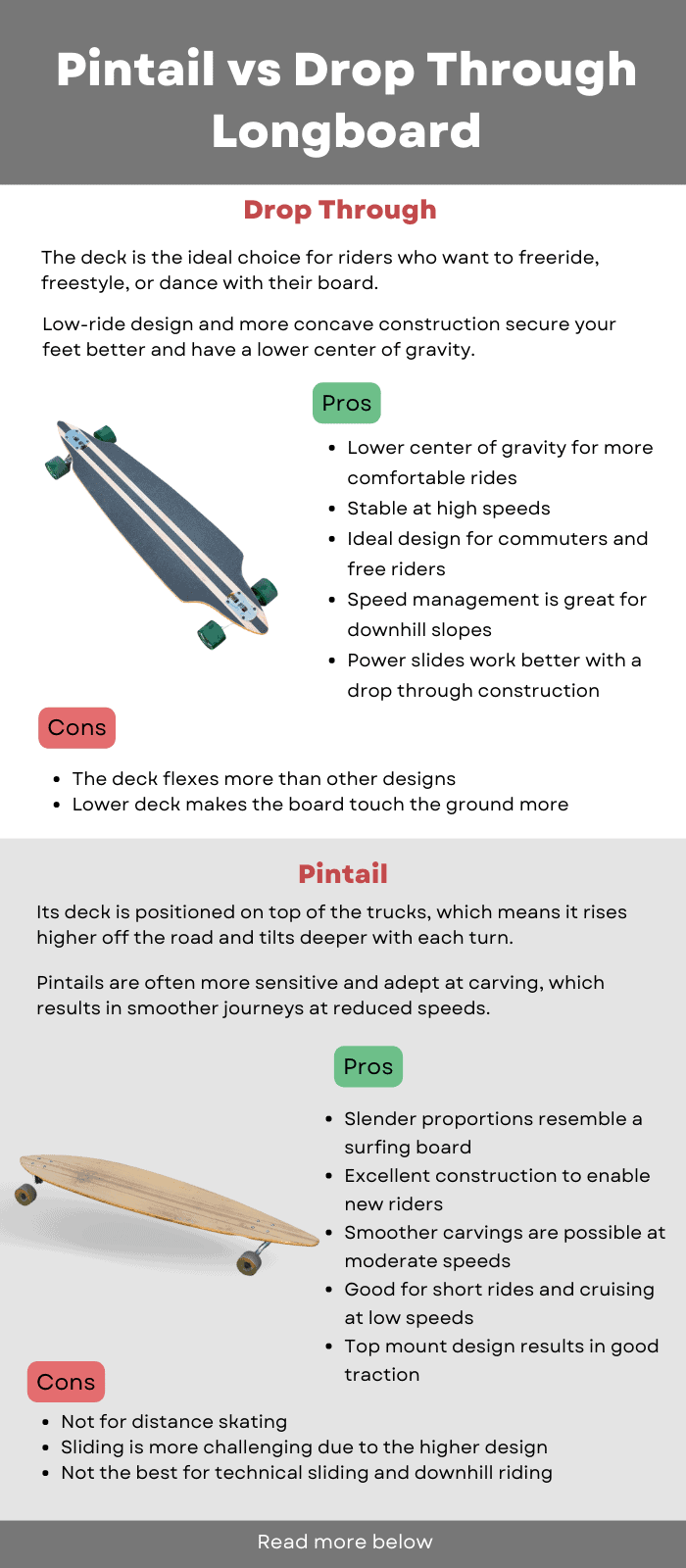If you are in the market for a new longboard, you may be unsure whether to get a pintail vs drop through model. Is there a significant distinction between the two?
Have you determined if you are a pintail rider or a drop through cruiser? Do not worry too much if you’re still undecided. Additionally, you may always purchase both sorts of longboards if desired.
When making a decision, one of the first things to consider is your ability level. Are you a novice skater? Are you certain that you have perfected your stance and balance abilities and are ready to progress to a faster board? Your skill level is critical while selecting the appropriate board.
There are also other things to evaluate for a pintail drop through longboard such as the form and size of the board and your intended objective for riding. Thus, it is natural for novices to be perplexed. To assist you in making your choice, below is some information regarding drop through and pintail longboards.
Table of Contents
Pintail vs Drop Through Comparison
Drop Through Longboards
The drop through is the board for endurance riding, traveling, and anybody seeking to slide or develop more sophisticated skating. Its trucks are attached through the deck.
This brings the board considerably closer to the earth, allowing for a more comfortable ride. The drop through longboard spins less violently and has a really solid feel — even at greater speeds — because of its drop through type trucks.
This is ideal for those who like to go further or who wish to commute. Drop through longboards are also sturdier for practicing to carve and performing new stunts since they are closer to the ground.
The deck is the obvious choice for riders that want to freeride, freestyle, or dance with their board.
Rides can occasionally be steep, and you may wish to increase your speed. With a drop through, riding on the steepest slopes will be more manageable. It secures your feet better and has a lower center of gravity due to its low ride design and more concave construction.
While you can slide on either a pintail or a drop through, if you’re serious about honing your power slides, you may as well select the drop through. Whether you’re just starting to slide or honing your deep slides, a drop through is always a safe option.
One of the most common learning curves for beginners on a drop through board is wrongly positioning their foot too much in front and inadvertently grabbing the wheels. On a drop through, you would not want to stand directly above the drop through truck.
The drop through is not without flaws and restrictions. One of them is that it is not very powerful in terms of weight distribution. The deck tends to flex greater than other types of longboard construction.
Another drawback of a drop through pintail longboard is that its low deck design may make it difficult to execute quicker turns. During sharper spins, the bottom of the board frequently touches the ground.
Pros
- Lower center of gravity for more comfortable rides
- Stable at high speeds
- Ideal design for commuters and free riders
- Speed management is great for downhill slopes
- Power slides work better with a drop through construction
Cons
- The deck flexes more than other designs
- Lower deck makes the board touch the ground more
Pintail Longboards
The pintail is one of the most iconic and classical longboard forms. Its proportions are slender and resemble those of a surfboard. This board layout is much less complex in appearance and significantly easier to construct for board makers.
It’s the platform that the majority of beginners go towards simply thanks to familiarity with the shape. Its deck is positioned on top of the trucks, which means it rises higher off the road and tilts deeper with each turn, giving the rider a floating sensation.
It is an excellent construction to start with, especially for new users looking to develop correct foot placement and poise. Additionally, it will push riders to seek the proper locations to pivot in order to prevent sliding off. Pintails are often more sensitive and adept at carving, which results in smoother journeys at reduced speeds.
Take the pintail design for brief excursions and relaxed riding. They are easy to maneuver and easier to carve. If surf-style cruising is something you had in mind, when deciding between pintail longboard vs drop through, pick the former. Due to the fact that it is top mounted, it allows for further carving without fear of wheel bite.
After some time spent with the pintail longboard, you can expect a pleasant time cruising around town. You can even progress to additional boards, such as a drop through deck, if you’re interested in developing new skills.
With the top mount deck, your feet and weight are placed directly over the trucks. This results in a more secure ride due to the increased traction on the wheels. This is why virtually all carving boards are top-mounted.
Because it’s higher above the ground, each push requires a deeper dipping of the foot, making it ideal for smooth cruising and carving, rather than distance riding. It may cause discomfort in your hips, lower back, and knees during long-distance skates.
Since the pintail is so high off the ground, it can be a little more challenging to learn how to slide.
Due to the small deck size and extremely mellow concave or flat deck, it lacks a strong foot lock-in, making it difficult to run at high speeds. Additionally, it is incompatible with technical sliding and downhill riding.
Pros
- Slender proportions resemble a surfing board
- Excellent construction to enable new riders to think of their actions
- Smoother carvings are possible at moderate speeds
- Good for short rides and cruising at low speeds
- Top mount design results in good traction
Cons
- Not for distance skating
- Sliding is more challenging due to the higher design
- Not the best for technical sliding and downhill riding
Conclusion
When it comes to pintail vs drop through, both have their advantages and disadvantages, and ultimately it comes down to your riding objectives. You may even have both boards to ensure that you are prepared to accomplish whatever you choose.
For grip, pintails generally feature a flatter deck or a very gentle concave. The opposite can be said for drop throughs, which frequently feature a higher concave angle to provide a more locked-in sensation for faster adventures.
Simply remember that pintails are designed for a surf-style ride and relaxed cruising, whilst drop throughs are more flexible and ideal for lengthy commutes.






